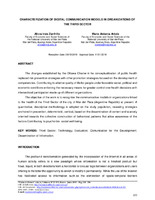| dc.rights.license | Licencia de Creative Commons Reconocimiento-NoComercial-CompartirIgual 4.0 Internacional (CC BY-NC-SA 4.0) | |
| dc.creator | Zanfrillo, Alicia Inés | |
| dc.creator | Artola, María Antonia | |
| dc.date.accessioned | 2020-06-25T14:53:42Z | |
| dc.date.available | 2020-06-25T14:53:42Z | |
| dc.date.issued | 2019-01-01 | |
| dc.identifier.citation | Zanfrillo, A. I., y Artola, M. A. (2019). Characterization of digital communication models in organizations of the third sector. Visión de Futuro, Revista Científica. Posadas (Misiones): UNaM. FCE. PPA; 23(1), 226-236. | |
| dc.identifier.issn | 1668-8708 | |
| dc.identifier.other | VF-002 | |
| dc.identifier.uri | https://hdl.handle.net/20.500.12219/2472 | |
| dc.identifier.uri | https://doi.org/10.36995/j.visiondefuturo.2019.23.01.001.en | |
| dc.identifier.uri | https://visiondefuturo.fce.unam.edu.ar/index.php/visiondefuturo/article/view/320/122 | |
| dc.description | Fil: Zanfrillo, Alicia Inés. National University of Mar del Plata. Faculty of Economic and Social Sciences; Argentine Republic. | en |
| dc.description | Fil: Artola, María Antonia. National University of Mar del Plata. Faculty of Economic and Social Sciences; Argentine Republic. | en |
| dc.description.abstract | The changes established by the Ottawa Charter in he conceptualization of public health replaced risk prevention strategies with other promotion strategies focused on the development of competencies. Contributing to a better quality of life for people under favorable social, political and economic conditions enforcing the necessary means for greater control over health decisions with intersectoral participation made up of different organizations.
The objective of the work is to recognize the communicative models in organizations linked to the health of the Third Sector of the city of Mar del Plata (Argentine Republic) at present. A quantitative, descriptive methodology is adopted on the study population, revealing strategies anchored in prevention, deterministic, vertical, based on the dissemination of content and scarcely oriented towards the collective construction of behavioral patterns that allow awareness of the factors Contributory to psycho-bio- social well-being. | en |
| dc.format | application/pdf | |
| dc.language.iso | eng | en |
| dc.publisher | Universidad Nacional de Misiones. Facultad de Ciencias Económicas. Programa de Posgrado en Administración | es_AR |
| dc.rights.uri | http://creativecommons.org/licenses/by-nc-sa/4.0/ | |
| dc.source | Visión de Futuro. Revista Científica (Misiones), 1-2019; 23(1): pp. 226-236. https://visiondefuturo.fce.unam.edu.ar/index.php/visiondefuturo/index | |
| dc.subject | Third Sector | en |
| dc.subject | Technology Evaluation | en |
| dc.subject | Comunication for the Development | en |
| dc.subject | Dissemination of Information | en |
| dc.title | Characterization of digital communication models in organizations of the third sector | en |
| dc.type | info:eu-repo/semantics/article | |
| dc.type | info:ar-repo/semantics/artículo | |
| dc.type | info:eu-repo/semantics/publishedVersion | |




